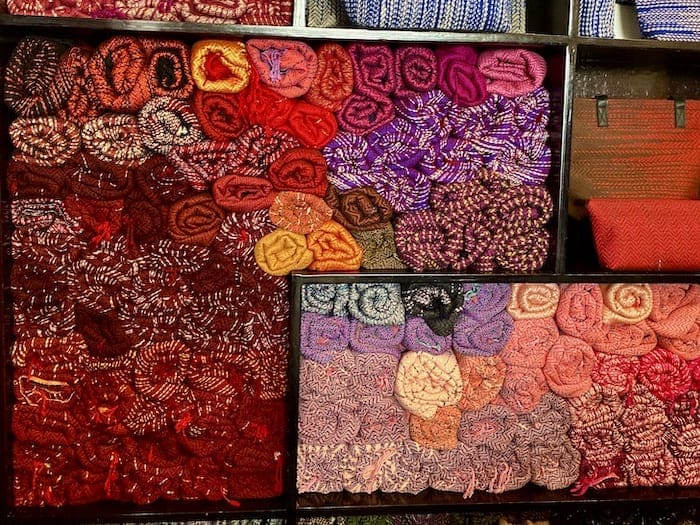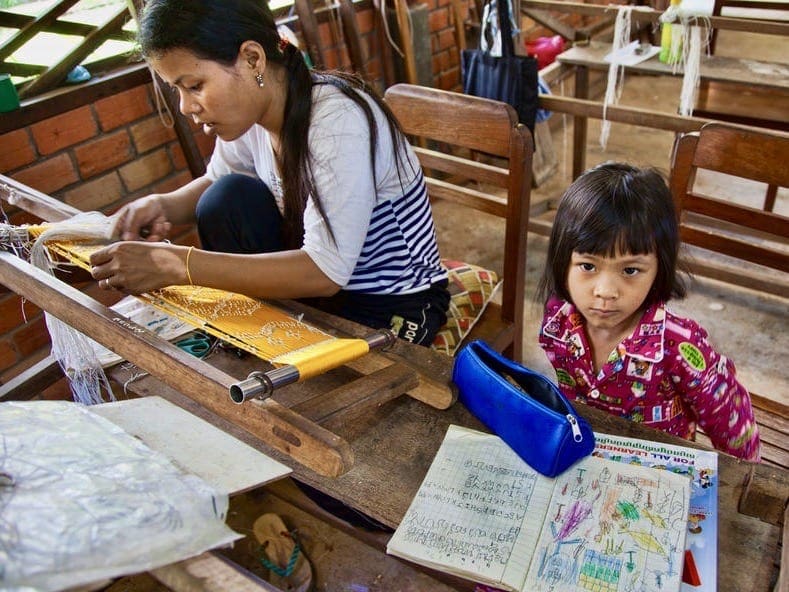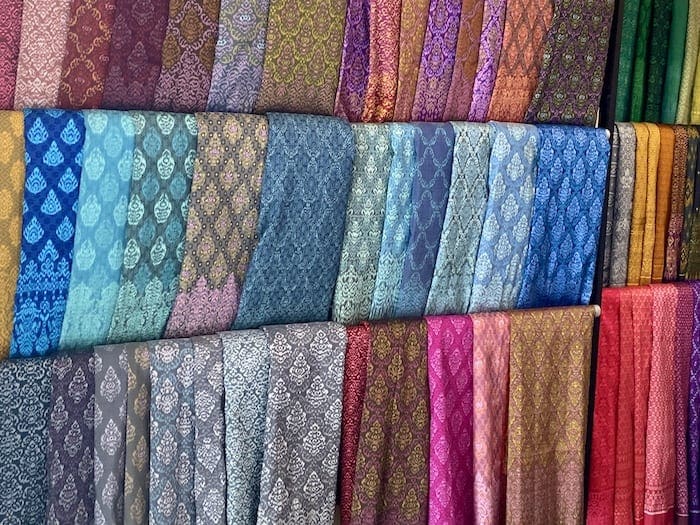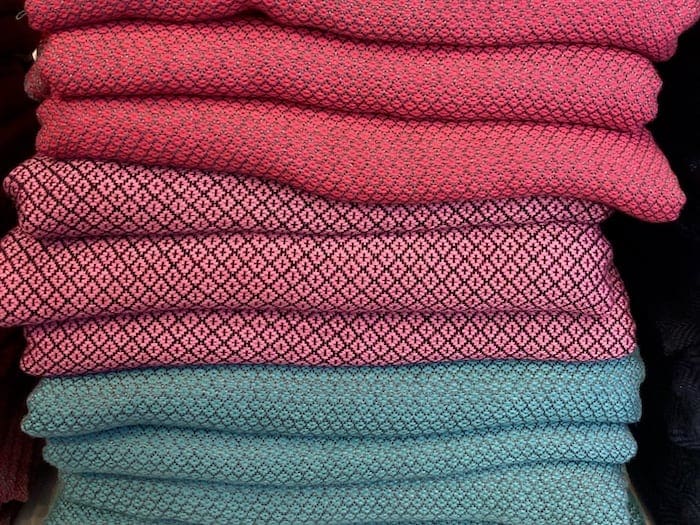Cambodia has a long and rich history of hand-weaving fabrics, like many handicrafts in Asia. It is a tradition and skill passed down from generation to generation.
Cambodia first started hand-weaving fabric in the 13th century. During the years of the Khmer Rouge era, a lot of the hand-weaving stopped production due to the political turmoil of the day. Since this period, many organizations have worked to help Cambodia revive its hand-weaving industry. Cambodia weaves three hand weaves: IKAT, twills, and plain weaves. In the past, most fabrics woven were 100% silk, but today, Cambodia is starting to weave some attractive blended fabrics.
Table of Contents
- A history of the start of textile weaving in Cambodia
- Helping Cambodians Keep Their Skill Of Textile Weaving Alive Today
- Types Of Traditional Handwoven Cambodian Fabrics
- Cambodian textile fabric blends
- Other Interesting Facts About Cambodian Handwoven Fabrics
- Frequently Asked Questions
- Related Content

A history of the start of textile weaving in Cambodia
The exact history of hand-weaving Cambodian textiles is not precisely known. The skill was believed to be brought to Cambodia during or before the Angkor period.
This is because ancient stone-carved reliefs on the wall of Angkor Wat show women wearing traditional Cambodian skirts, which are very similar to what is being worn in present-day Cambodia. These skirts are believed to have been hand-woven.
There is a very interesting history of Cambodia during the Angkor Wat period that was written by Zhou Daguan, a Chinese diplomat who lived in Cambodia between 1296 and 1297. Besides Zhou Daguan making observations about Cambodian daily life and trade, he also spoke a bit about their fabrics and their weaving.
Here is a quote from Zhou Daguan about the Emperor and the clothes he would wear:
“Only the ruler can dress in cloth with an all-over floral design…Around his neck he wears about three pounds of big pearls. At his wrists, ankles and fingers he has gold bracelets and rings all set with cat’s eyes…When he goes out, he holds a golden sword [of state] in his hand.”
zhou daguan
He spoke of how the Cambodian people had spaced floral designs imported from India. But also, while he was in Cambodia, the Cambodians were raising silkworms and weaving fabrics. So we know that during the Angkor period, Cambodia was raising silkworms, spinning yarns, dyeing the yarns, and weaving fabrics.

Zhou Daguan further observed that all the traders In Cambodia at the time were women, not men. Women played an essential role in Cambodian society by not only weaving fabrics but also trading of fabrics and other goods.
This quote from Zhou Daguan explains the role Angkor women played in Cambodia’s ancient society.
“The local people who know how to trade are all women. So when a Chinese goes to this country, the first thing he must do is take in a woman, partly with a view to profiting from her trading abilities.”
Zhou Daguan
So, during this time in Cambodia, the women would not only handle all the trade but also spin the yarns, weave the fabric, and sell it. It is said that mothers usually pass on their knowledge of dyeing, spinning, and weaving fabrics to their daughters.
War, genocide, and its effect on the Cambodian textile industry
The Cambodian or Khmer lifestyle, including the hand-weaving industry, was all highly disrupted from 1970 to 1979 and 1993. Handweaving was one of the traditional handicrafts that were considered to be highly affected by not only the change of government, the Khmer Rouge genocide, and the invasion of the Vietnamese in Cambodia.
One of the problems is due to the wars, genocide, and other things that Cambodia went through during this period. Some research has shown that for present-day Cambodia, the population of people ages 69 to 79 is in proportion with those under 33 years old, but a large chunk of the population is missing between the ages of 34 and 69. This also means Cambodian has a highly imbalanced demography that continues to affect them today.
In other words, when many women should have been home learning to weave from their mothers, they could not do so, or they were killed. Many of them lost these skills or never learned them.
Many groups in Cambodia have understood the loss of this essential traditional skill due to Cambodia’s chequered past. So, over the last 20 years, many organizations have come forward to help revitalize Cambodia’s hand-woven fabric industry.
Helping Cambodians Keep Their Skill Of Textile Weaving Alive Today
We work with several organizations whose main purpose is to help keep the weaving of Cambodian textiles alive in Cambodia today. This is because they understand that hand-weaving is a rich skill that could be lost and a skill of great economic importance.
After Myanmar, Cambodia is one of the poorest countries in Asia. Over the years, Cambodia has made great strides to lift its population out of poverty. However, still, there is a lot of poverty in Cambodia, especially in the countryside.
Cambodia has been able to help many people get out of poverty due to the now thriving textile and tourism industry. But there are still many areas of Cambodia where much of the population lives at or way below the world poverty level.

Purchasing Cambodia Traditional Textiles Helps Women and Children in Cambodia
The World Bank still estimates that despite all these strives that Cambodia has made in recent years to alleviate poverty, that a child born in Cambodia today will still have a 49% less productive life when compared to other children due to the fact many children still do not have access to good quality education, health care, and other basic needs.
Today, 29% of Cambodia’s population still does not have access to proper water, and over 49% do not have access to proper sanitation.
Indirectly purchasing textiles woven by Cambodian women helps alleviate this poverty cycle. The extra income these women earn can, in turn, help their families, including their children.
We work with an organization with over 280 weavers in the Banteay Meanchey Province in North-Western Cambodia. These weavers are mainly women who need to help supplement their family’s farming income.
Without weaving, these families would have a tough time economically surviving. Weaving also allows many of these women to be able to weave at home or near their homes so they can still tend to the needs of their families.
Types Of Traditional Handwoven Cambodian Fabrics
Most Cambodian fabrics use a lot of silk or are 100% silk. Today, Cambodia still imports a lot of its silk threads from China, Vietnam, and Thailand. These imported silk yarns are usually white in color, as traditional Cambodian silkworms are usually yellow.
Yellow cocoons are considered a more natural kind of silk, as white silk is a hybrid kind of silk cocoon that does not do well in Cambodia’s hot temperature and heat. Because of this, the silk threads from the Cambodian yellow cocoons are usually more expensive than many of the imported silk threads.
Traditionally, Cambodian silk was dyed using only natural dyes. Though some producers may still use natural dyes today, most do not use natural dyes due to issues with colorfastness or the color itself.
Many of the better suppliers will use a German vs. a Chinese fabric dye as the German dyes are usually considered to be better quality.

There are three basic types of Cambodian hand-woven fabrics. The fabrics are divided into three main groups according to how they are used how the yarn is dyed and the fabric itself is woven.
Three Main Types Of Cambodia Handwoven Fabric Weaves:
Cambodia is a country that has long been known for its intricate handwoven fabric weaves, creating textiles with remarkable intricacy and beauty. From the traditional fabrics of Angkor Wat to the more modern patterns favored by contemporary fashion markets, Cambodia’s diverse textile practices have made it one of the most renowned nations for weaving.
With various variations, from basic to ikat weaves, Cambodian hand-woven fabrics will surely lend color and texture to any application.
Read on to learn about the three main types of Cambodian fabric weaves.
IKAT –
There are various kinds of IKAT, but IKAT fabric is considered one of the main Cambodian fabric weaves. IKAT involves the tying section of the weft yarn that will resist a dye. Those sections not dyed or dyed in another color will form a pattern on the weft and eventually on the fabric itself.
Twill-like textures –
The handlooms in Cambodia will weave a lot of twill-like textures. They can put these twill designs into a variety of patterns.
Basic weave –
The other weave would be considered a basic weave, like a plain-colored fabric or a striped fabric. They will weave fabrics where the weft may be a different color than the warp threads, ensuring that different colors will show different light when looking at the fabric.

Cambodian textile fabric blends
Today, besides just weaving 100% silk fabric, Cambodia has also started to weave quite a few blended fabrics. Many of these blends are very nice, especially those with some silk.
Here is one of the fabrics we like as we feel like the hand-feel of the fabric is very pleasant due to the fabric having some silk in it.
Natural Yarns –
The yarns are processed from the pulp of plants such as bamboo, sugar cane, eucalyptus, and etch.
Wool and Silk –
The yarns are mixed with natural macromolecule proteins like wool and silk. There are about 11% silk yarns in the fabric.
Quality AZO-Free Dyes –
The dyes that are used are AZO-free dyes. In many places, AZO dyes are banned as they are considered harmful, so we are using only dyes that are considered AZO-free.
Colorfastness certified –
Fabric yarns are also certified and tested to pass the light colorfastness requirements.

Cambodian artisans are weaving fabrics that will help them use modern yarns and designs with their traditional handlooms. This allows these artisans to continue to pass the skills they are learning on to their children while ensuring that Cambodia has a rich textile-weaving history.
Working with Mondoro to design, develop, and manufacture these hand-loomed fabrics not only helps to keep this hand-weaving tradition alive, but it also helps Cambodia and in particular, these Cambodian women to earn a fair wage and get out of the poverty cycle.
Other Interesting Facts About Cambodian Handwoven Fabrics
What is the difference between Thai silk vs. Cambodian silk?
Thai silk and Cambodian silk are very similar. Thailand’s robust Thai silk industry has been designing, weaving, and manufacturing Thai silk for export for many years.
For these reasons, Thai silk manufacturers understand much about weaving, quality, and colors for Western silk consumption. It can be said that many Cambodian silks have the same feels as Thai silks, but they may not have the array of colors and designs that many Thai silk suppliers offer.
One of the most famous and premier Thai brands of silk is silk, designed and manufactured by Jim Thompson. You can find out more about the Jim Thompson brand by clicking here.
There is little doubt that a designer of the quality of Jim Thompson and his legacy has helped drive the Thai silk industry and helped to give the Thai silk industry an advantage over the Cambodian industry regarding designs and colors that will sell well in the western markets.
Is there an advantage to using handlooms vs. a machine loom to weave silk?
When you weave by hand or machine, the two fabrics look very different when viewed closely. For a fabric that is handlooms, you may see slight variations to the warp, whereas for a fabric that is machined, typically the warp or how it is woven will be almost perfect.
With handlooms, every piece can be just a bit different, as different weavers may have different strengths when they run the yarn through the warp.
One of the main advantages of using handlooms is that it is usually not as costly to set up the loom for a new color and fabric design. Setting up the weft on a machine-to-weave design can be very costly and this is also why many machine suppliers may ask for a very high minimum for each design.
They need these high minimums to justify setting up the warp on the loom. Usually, handlooms can accept much lower minimums to set up the weft on the loom. This means you can do many more unique designs, colors, and finished fabrics than on a machine loom.
Find out more about how Mondoro can help you create, develop, and manufacture excellent home decor, textiles, and furniture products – don’t hesitate to contact me, Anita. Check out my email by clicking here or become a part of our community and join our newsletter by clicking here.
Mondoro gives out a FREE Lookbook to anyone interested. You can receive a copy of our latest Lookbook by clicking here.
Listen to our Podcast called Global Trade Gal. You can find it on all major podcast platforms. Try out listening to one of our podcasts by clicking here.
Subscribe to our Mondoro Company Limited YouTube Channel filled with great videos and information by clicking here.
Frequently Asked Questions
1. What is the history of hand-woven fabrics in Cambodia?
Cambodia has a rich history of hand-weaving fabrics dating back to the 13th century. It is a tradition that has been passed down through generations.
2. How did the Khmer Rouge era impact Cambodia’s hand-weaving industry?
During the Khmer Rouge era, much of the hand-weaving production in Cambodia came to a halt due to political turmoil and social upheaval.
3. What efforts have been made to revive Cambodia’s hand-weaving industry after the Khmer Rouge era?
Since the Khmer Rouge era, numerous organizations have worked diligently to help Cambodia rejuvenate its hand-weaving industry.
4. What are the three main types of hand weaves in Cambodia?
Cambodia is known for three primary hand-weaving techniques: IKAT, twills, and plain weaves.
5. Was silk the predominant fabric used in traditional Cambodian hand-weaving?
In the past, most fabrics woven in Cambodia were made from 100% silk.
6. What types of fabrics are woven in Cambodia today?
Today, Cambodia is diversifying its hand-woven fabrics, including attractive blended fabrics.
7. What is the significance of IKAT weaving in Cambodian textile traditions?
IKAT weaving is a prominent and intricate technique in Cambodian textile traditions, known for its unique patterns and dyeing methods.
8. How do Cambodian weavers create the vibrant colors and patterns seen in their fabrics?
Cambodian weavers achieve vibrant colors and patterns through a combination of traditional dyeing methods and intricate weaving techniques.
9. Are there any regional variations in hand-woven fabrics across Cambodia?
Yes, different regions of Cambodia may have their own distinct weaving styles, patterns, and color palettes.
10. Where can one purchase authentic Cambodian hand-woven fabrics today?
Authentic Cambodian hand-woven fabrics can be found in local markets, specialized craft shops, and through fair trade organizations that support the country’s weaving communities.
Related Content
Buying Guide For Outdoor Furniture Fabrics, What You Need To Know
Your choice of outdoor fabric for your outdoor furniture collection will make a difference in how long the fabric will last. There are ten key points to consider when making your outdoor fabric selection. Proper maintenance and care will also help expand the fabric’s life cycle.
You can discover more by reading Buying Guide For Outdoor Furniture Fabrics, What You Need To Know by clicking here.
All About Hmong Batik Fabrics, What You Need to Know
Batik fabric is putting a design on a piece of fabric by using wax. The fabric is then dyed, and the areas where the wax is put on the fabric will be left undyed, leaving a pattern on the fabric. The Hmong in North Vietnam will use this technique for their traditional clothing. The Hmong batiks are also a great fabric for many Home Decor products, as they use vibrant indigo dyes to make their batik fabric.
You can discover more by reading All About Hmong Batik Fabrics, and What You Need to Know by clicking here.

